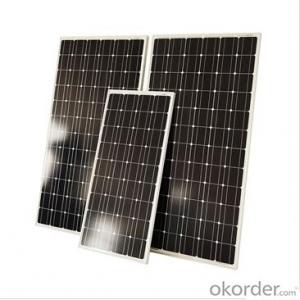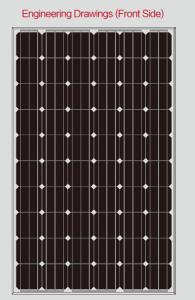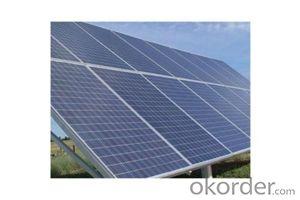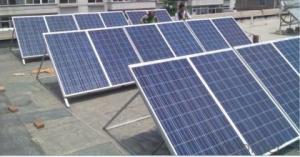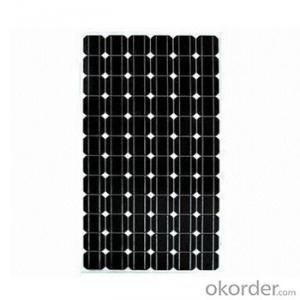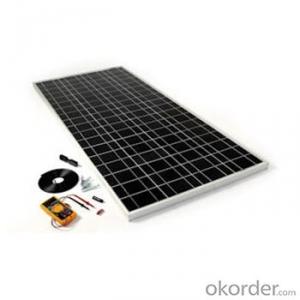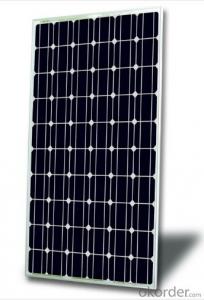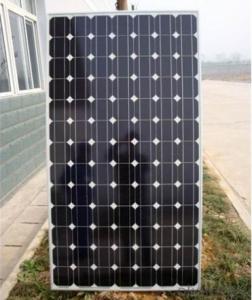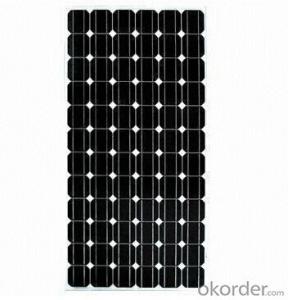Solar Panels West Sussex - Solar Monocrystalline Series Panels 180w
- Loading Port:
- Shanghai
- Payment Terms:
- TT OR LC
- Min Order Qty:
- 100 pc
- Supply Capability:
- 50000 pc/month
OKorder Service Pledge
OKorder Financial Service
You Might Also Like
Introduction of Solar Monocrystalline Series Panels
CNBM Solar photovoltaic (PV) Panel is designed for large electrical power requirements. It is the optimal choice for both on-grid and off-grid power systems. CNBM Solar panel offers high performance of power per square foot of solar array. Monocrystalline silicon(c-Si): often made using the Czochralski process. Single-crystal wafer cells tend to be expensive, and because they are cut from cylindrical ingots, do not completely cover a square solar cell module without a substantial waste of refined silicon. Hence most c-Si panels have uncovered gaps at the four corners of the cells.
Characteristics of Solar Monocrystalline Series Panels
I Solar Cell : High efficiency crystalline solar cell. Even if under the weak light, the solar module can produce maximum power output.
II Tempered glass (toughened glass): Anti-reflecting coating and high transmission rate glass increase the power output and mechanical strength of solar module.
III EVA and TPT: Using high quality EVA and TPT to prevent destroying and water.
IV AI frame: Without screw, corner connection. 6 holes on the frame can be installed easily.
V Junction box: Multi function junction box with water proof.
VI Long lifetime: ≥25 years; Less power decrease
VII Good performance of preventing from atrocious weather such as wind and hails.
VIII Resisting moisture and etching effectively, not effected by geology.
Standard Test Conditions of Solar Monocrystalline Series Panels
The opto-electrical specifications shown below are stabilized values being measured at Standard Test Conditions, Irradiance: 1000W/m2, Spectrum: AM1.5 at 25°C, The info below is subject to manufacturing tolerances. Where appropriate minutes of measurement are available and are used for the dimensioning of the installation.
Advantages of Solar Monocrystalline Series Panels
• CNBM Solar performance guarantees for 25 years
• 12 years guarantee for workmanship
• Timeliness of delivery
CNBM International Corporation's products including Monocrystalline Solar Panel, Polycrystalline Solar Panel have received and enjoyed famous reputation in many countries and regions in the world .As a solar panel supplier in China, we strive to provide our customers with excellent service, superior products and unmatched value.
ITEM NO. | NBJ-180M | NBJ-175M | NBJ-170M |
Maximum Power (W) | 180 | 175 | 170 |
Optimum Power Voltage (V mp) | 35.14 | 35.14 | 35.14 |
Optimum Operating Current (I mp): | 5.13 | 4.99 | 4.85 |
Open Circuit Voltage (Voc) | 43.2 | 43.2 | 43.2 |
Short Circuit Current (ISC) | 5.48 | 5.32 | 5.18 |
Cell Efficiency (%) | 17% | 16.50% | 16.03% |
Module Efficiency (%) | 14% | 13.70% | 13.32% |
FF (%) | 70-76% | ||
Warranty | 90% of 10 years, 80% of 25 years. | ||
Standard Test Conditions | AM1.5 1000W/m2 25 +/-2°C | ||
Bypass Diode Rating (A) | 12 | ||
Cable & Connector Type | Pass the TUV Certificate | ||
Size of Module (mm) | 1580*808*35 | ||
Solar Cell | 125*125 Mono | ||
Backing (Material) | TPT | ||
Frame (Material Corners, etc.) | Aluminum-alloy | ||
Number of Cell (PCS) | 6*12 | ||
N/W(KG) | 15.5 | ||
Junction Box Type | Pass the TUV Certificate | ||
Tolerance Wattage (e.g. + /-5%) | ±3% | ||
Front Glass Thickness (mm) | 3.2 | ||
Surface Maximum Load Capacity | 5400Pa | ||
Allowable Hail Load | 23m/s, 7.53g | ||
Packing | 1*20'GP | 364pcs | |
1*40'GP | 722pcs | ||
Temperature Coefficients of ISC(%): | 0.04 | ||
Temperature Coefficients of Voc(%): | -0.38 | ||
Temperature Coefficients of Pm(%): | -0.47 | ||
Temperature Coefficients of IM(%): | 0.04 | ||
Temperature Coefficients of VM(%): | -0.38 | ||
Temperature Range | -40°C to +85°C | ||
FAQ
We have organized several common questions for our clients,may help you sincerely:
1.What’s price per watt?
A: It’s depends on the quantity, delivery date and payment terms of the order. We can talk further about the detail price issue. Our products is high quality with lower price level.
2. Can you tell me the parameter of your solar panels?
We have different series of cells with different power output, both from c-si to a-si. Please take our specification sheet for your reference.
3.How do you pack your products?
We have rich experience on how to pack the panels to make sure the safety on shipment when it arrives at the destination.
4.Can you do OEM for us?
Yes, we can.
5.How long can we receive the product after purchase?
In the purchase of product within three working days, We will arrange the factory delivery as soon as possible. The perfect time of receiving is related to the state and position of customers. Commonly 7 to 10 working days can be served.
- Q: i need how a solar panel works, if possible make as easy to understand as possible like because of this , this happens and if you could please put a web source you got it from
- How okorder /... Use the next page link to flip through the article.
- Q: Can solar panels be installed on an RV or camper?
- Yes, solar panels can be installed on an RV or camper. In fact, many people choose to install solar panels on their recreational vehicles to harness renewable energy and reduce reliance on traditional power sources while on the road. Solar panels can provide a sustainable and efficient way to charge batteries, power appliances, and even run electrical systems in an RV or camper.
- Q: If you need 9400 watts, 75 amps@ 240V, how many solar PV panels do you need?
- 75 amps @ 240 volts equals 8 kW not 9.4 kW, so first you have to make up your mind how much you want. Then you have to decide what size of solar panel you want. If it helps, the 6 units on our roof, each approximately m square, are rated for 4 kW in bright sunshine.
- Q: i attached a usb charger to my solar panel(it has an output of about .2 volts) but i read on my multimeter its only using about 8 volts however on the conventional wall charger that i use to charge it has an output of about 5. volts.... i believe that my mp3 player is not charging it does not display the charging icon when it is on or off ....is this becuase the output is higher ? do i need to install a volt dropping diode to prevent it from putting to much energy at once? (my mp3 charges fine on the wall charger but does not seem to respond to the solar panel so it the circuits are fine....)
- You description is not clear as to what is supplying and what is consuming the .2, 8, and 5. volts you mention. I get that your solar panel output is .2 VDC (volts DC), but is that open circuit or under load? Also, is the charger output AC or DC? What's using 8 volts? Circuits don't selectively use a portion of the voltage supplied. They use all or nothing. Is the polarity correct from your solar panel to your MP3 player? If your MP3 player requires DC for charging and you're feeding it the correct polarity, but too high a voltage, an overvoltage protection circuit in your MP3 charging circuit might be blocking the charging current from your solar panel. Go through everything again and if you need to post another question on YA, be specific as to what you're measuring, where, and whether it's the source or load you're measuring.
- Q: Can solar panels be used on boats or marine applications?
- Yes, solar panels can be used on boats and marine applications. They are a sustainable and efficient way to generate electricity, especially in areas with ample sunlight. Solar panels can be easily installed on the deck or roof of a boat, providing power for various onboard systems such as lighting, navigation equipment, and charging batteries. Additionally, solar panels help reduce reliance on fossil fuels and minimize the carbon footprint of marine activities.
- Q: Can solar panels be recycled?
- Yes, solar panels can be recycled. The process involves separating the different components, such as glass, metals, and silicon, which can then be reused in the production of new panels or other products. Recycling solar panels helps reduce waste and promotes the sustainable use of renewable energy technology.
- Q: are solar panels just a photodiode?A Photodiode converts light into either current or voltage? Right?
- Yes, so are camera sensors. Except in cameras they're specially desgined to reduce noise.
- Q: Can solar panels be installed on museums or cultural centers?
- Yes, solar panels can be installed on museums or cultural centers. In fact, many museums and cultural centers are adopting solar energy systems to reduce their carbon footprint and save on electricity costs. Solar panels can be installed on rooftops, parking lots, or even as shade structures, providing clean and renewable energy for the facility's operations.
- Q: How do solar panels affect the property's overall sustainability?
- Solar panels can greatly enhance a property's overall sustainability by generating clean and renewable energy from the sun. By reducing reliance on fossil fuels and lowering carbon emissions, solar panels contribute to a greener environment. Additionally, solar energy can help reduce electricity bills and provide a reliable and independent source of power, making the property more self-sufficient and resilient.
- Q: Does anyone own any and would you recommend them? right now i only own solar stake lights and i use them during the summer in my yard. But during the winter i take them out because they don't charge well. I live in toronto canada where it snows a lot during the winter, would it even be worth it to buy solar panels? Would they get covered with snow if the were mounted on my roof and get ruined? I plan on buying some when i purchase my own home.Any info would be appreciated:)
- The best sort of solar panel for $ to energy is the hot water type that use a vacuum tube system to heat your water. This saves you money on heating water and is relatively cheap to install compared to other things like wind or PV solar. I'm not too sure about where you live (I'm in the westcountry of the UK where wind energy IS viable... but usually it isn't). The best sort of Photo voltaic solar panel (that makes electricity)is still expensive yet very reliable as they only need photons to fall on them not neccessarily full sunshine and they are improving all the time. It depends on the pitch of your roof as to whether snow settles on them. One can have a system that sells power back to the national grid and then you buy what you need with a discount for what you produce. Obviously if you can afford enough panels one could even make a profit. Or you can go self-sufficient, but then you need batteries and an inverter to convert your 2 volt battery output back to 20 volts or whatever you use (it's 240 volts in the UK). Then it's a matter of how efficient your batteries are in amp hours. Dry mainainence free deep cycle batteries are best for this job and quite expensive still. Wind generators are only really practical if you can mount them high enough from the ground to where there is more constant wind. As I said that depends where you live and the prevailing winds. The very small ones are basically useless except for emergency lighting or something, so one needs a fairly large turbine to produce enough power for a modern home so planning restrictions should be considered when going down this road. For now, solar power is definitely the way to go, even as far North on this planet as Canada and the UK. Good luck. Once you have the system it's basically FREE energy!
Send your message to us
Solar Panels West Sussex - Solar Monocrystalline Series Panels 180w
- Loading Port:
- Shanghai
- Payment Terms:
- TT OR LC
- Min Order Qty:
- 100 pc
- Supply Capability:
- 50000 pc/month
OKorder Service Pledge
OKorder Financial Service
Similar products
Hot products
Hot Searches
Related keywords
